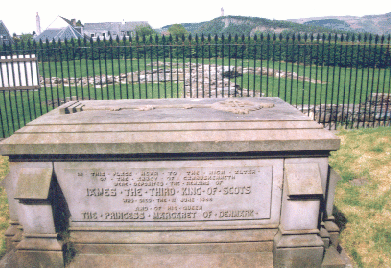![]()
![]()
![]()
![]()

![]()
As a boy Andrew Wood's greatest ambition was to be a merchant-trader like his father. He was also determined to avenge his father, slain by the English privateers off the coast of the Isle of May.
Andrew's chance came when he joined his Kinsman, Henry Lindsay, in a trading venture with the Baltic states. During the voyage they were attacked, and Andrew's great courage during this and subsequent skirmishes led to his national renown as a pirate-slayer, and brought him to the attention of King James the third.
At the King's invitation, Wood built up a number of captured vessels to form the nucleus of a national fleet. Such was his success that James eventually promoted him to become Barron of Largo and Lord High Admiral of Scotland.
Admiral Wood's bold defence of Scottish waters was to incur the wrath of King Henry VII of England Wood was now in great danger.
But, never able to resist a challenge, he still found time to undertake a hazardous voyage to Iceland in search of walrus tusks and build up a highly lucrative ivory trading business.
In his own inimitable style, Nigel Tranter tells the incredible story of how this humble Laird from Largoshire became Scotland's most famous sailor and one of the King's most valued officers-of-state, a skilled negotiator who greatly aided his nation's cause at a time of international unrest.
![]()
James III's son, the Duke of Rothesay, had been held by various powerful nobles and the uprising against James III that followed led to the Battle of Sauchieburn. James was thrown from his horse, carried indoors and was subsequently assasinated. His distraught son kept the iron bands in which he had been held all his life as a reminder of what had happened.
James IV secretly hid his fathers body in Stirling Castle as the nobles wished to bury the body in Dunfermline Abbey. James IV wished his father to rest in Cambuskenneth beside his mother, Margaret, who had died some two years earlier.
In 'The Admiral' Nigel has James enlist Andrew Wood's help to secretely inter the body. This event is described as follows;
Quote from 'The Admiral' page 113.
In the morning Kestrel sailed westwards then nearly thirty miles, Beth insisting on attending this peculiar funeral. They duly found James and his assistants awaiting them, with Abbot Henry, Cambuskenneth was a fine Abbey, dating from 1147, one of the many founded by the pious David the First, with mainly English money gained by his marrying the richest heiress in the all England, but dedicated to it the Virgin Mary. The name meant the creak of Cainneach, one of St Columba's disciples. Here, highly suitably Bruce had received the surrender of the English nobles after the victory of Bannockburn. The Abbey consisted of a large cruciform church and chapter-house, with monastic buildings nearby in this quite tight crook of the winding river. It had a great square parapeted tower seventy feet high, and dominated all those watery levels.
They rowed ashore, the newcomers found all in readiness. The dead monarch was in a simple oak coffin, this lying in a cavity in the stone flooring before the high altar, beside the grave of Queen Margaret, a great plain slab ready to place over it. There was no delay now. Abbot Henry conducted a brief and simple burial ceremony, prayers were said for the soul of the departed, water was sprinkled on coffin and cavity, and the body lowered into its resting place. All stood in silence, heads bowed, for an interval, and then the heavy slab was lowered into position, hiding all, no indication left that there was any partner for the Queen's tomb. In due course a suitable carving would be made on the slab, but meantime there was to be nothing to draw attention to the new grave."
End of quote.
The coffins of James the third and his Queen, Margaret remained undisturbed under the floor of Cambuskenneth Abbey until 1865 when, during archaeological survey, they were disinterred and subsequently reburied at Queen Victoria's expense. This would be the time that the monument, in the photographs below, together with the surrounding fence were erected.


